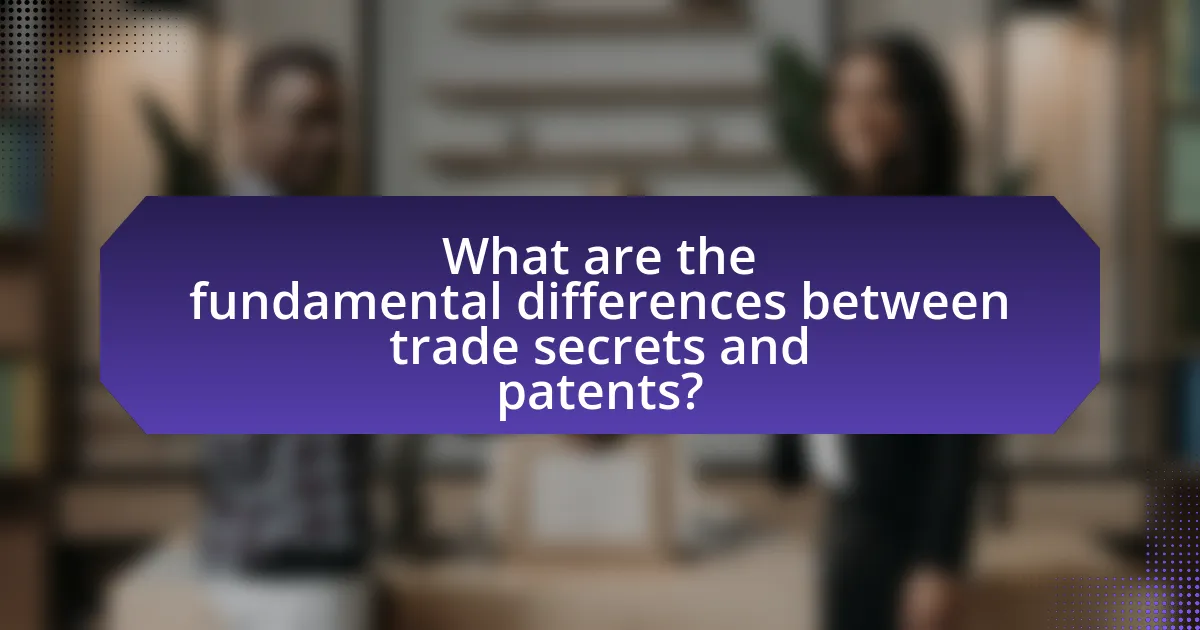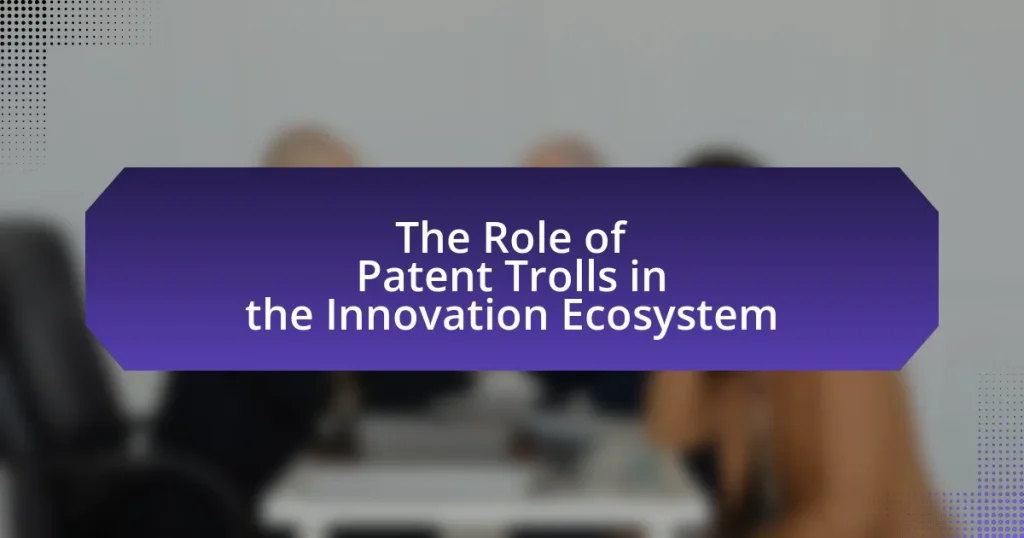The article focuses on the fundamental differences between trade secrets and patents as strategies for protecting intellectual property. It outlines how trade secrets safeguard confidential business information indefinitely without formal registration, while patents provide exclusive rights for a limited duration, typically 20 years, after public disclosure. Key topics include the types of information classified as trade secrets, measures for maintaining confidentiality, the patent application process, and the advantages and risks associated with each protection strategy. Additionally, the article discusses factors influencing the choice between trade secrets and patents, long-term considerations for intellectual property protection, and best practices for ongoing safeguarding of these assets.

What are the fundamental differences between trade secrets and patents?
Trade secrets and patents differ fundamentally in their protection mechanisms and duration. Trade secrets protect confidential business information that provides a competitive edge, such as formulas or processes, without any formal registration, as long as the information remains secret. In contrast, patents grant exclusive rights to an inventor for a limited time, typically 20 years, after disclosing the invention to the public. This means that while trade secrets can potentially last indefinitely if kept confidential, patents require public disclosure and have a finite protection period.
How do trade secrets provide protection for intellectual property?
Trade secrets protect intellectual property by safeguarding confidential business information that provides a competitive advantage. This protection is achieved through legal measures that prevent unauthorized disclosure or use of the information, such as formulas, practices, processes, or designs. Unlike patents, which require public disclosure and have a limited duration, trade secrets can remain protected indefinitely as long as the information is kept secret and reasonable efforts are made to maintain its confidentiality. For example, the Coca-Cola formula has been a trade secret for over a century, demonstrating the effectiveness of this protection strategy in preserving valuable intellectual property.
What types of information can be classified as trade secrets?
Trade secrets can include formulas, practices, processes, designs, instruments, patterns, or compilations of information that provide a business advantage over competitors who do not know or use them. For example, the Coca-Cola formula is a well-known trade secret that gives the company a competitive edge in the beverage industry. Additionally, customer lists, marketing strategies, and proprietary software can also be classified as trade secrets, as they are not publicly known and are subject to efforts to maintain their secrecy. The Uniform Trade Secrets Act defines trade secrets as information that derives independent economic value from not being generally known and is subject to reasonable efforts to maintain its secrecy.
What measures are necessary to maintain the confidentiality of trade secrets?
To maintain the confidentiality of trade secrets, organizations must implement a combination of legal, physical, and procedural measures. Legal measures include non-disclosure agreements (NDAs) that bind employees and partners to confidentiality, ensuring that sensitive information is not disclosed without permission. Physical measures involve restricting access to sensitive areas and using security systems to protect documents and electronic data. Procedural measures include training employees on the importance of confidentiality, establishing clear protocols for handling sensitive information, and regularly reviewing and updating security practices. These measures collectively create a robust framework that safeguards trade secrets from unauthorized access and disclosure.
What role do patents play in protecting inventions?
Patents play a crucial role in protecting inventions by granting inventors exclusive rights to their creations for a specified period, typically 20 years. This exclusivity prevents others from making, using, or selling the patented invention without permission, thereby incentivizing innovation and investment in research and development. According to the World Intellectual Property Organization, patents encourage technological advancement by ensuring that inventors can reap the financial benefits of their inventions, which fosters a competitive market and drives economic growth.
What are the different types of patents available?
The different types of patents available are utility patents, design patents, and plant patents. Utility patents protect new and useful processes, machines, articles of manufacture, or compositions of matter, and they account for the majority of patents granted. Design patents safeguard the ornamental design of a functional item, while plant patents are issued for new varieties of plants that have been asexually reproduced. According to the United States Patent and Trademark Office, these classifications ensure that inventors can protect their innovations effectively across various fields.
How does the patent application process work?
The patent application process involves several key steps: filing a patent application, examination by a patent office, and potential issuance of a patent. Initially, an inventor submits a detailed application that includes claims defining the invention, drawings, and an abstract. The patent office then reviews the application for compliance with legal requirements and assesses the novelty and non-obviousness of the invention. This examination process can take several months to years, depending on the jurisdiction and complexity of the application. If the application meets all criteria, the patent office grants a patent, providing the inventor exclusive rights to the invention for a specified period, typically 20 years from the filing date.
Why might a business choose trade secrets over patents?
A business might choose trade secrets over patents to maintain indefinite protection without public disclosure. Unlike patents, which require detailed public documentation and expire after a set period, trade secrets can be kept confidential indefinitely as long as reasonable measures are taken to protect them. For instance, the Coca-Cola formula has been a trade secret for over a century, demonstrating how businesses can leverage trade secrets for long-term competitive advantage without the limitations associated with patent expiration.
What are the advantages of using trade secrets for protection?
The advantages of using trade secrets for protection include indefinite duration, as trade secrets remain protected as long as they are kept confidential, unlike patents which expire after a set period. Additionally, trade secrets do not require public disclosure, allowing businesses to maintain competitive advantages without revealing their proprietary information. This confidentiality can lead to greater market control and profitability, as companies can leverage unique processes or formulas without the risk of competitors gaining access through patent filings. Furthermore, trade secrets can be less costly to maintain than patents, as they do not involve the expenses associated with patent application and enforcement.
What are the potential risks associated with trade secrets?
The potential risks associated with trade secrets include unauthorized disclosure, loss of competitive advantage, and difficulty in enforcement. Unauthorized disclosure can occur through employee turnover or corporate espionage, leading to sensitive information being leaked to competitors. This loss of confidentiality can result in diminished market position and financial losses. Additionally, enforcing trade secret protection can be challenging, as it often requires proving that reasonable measures were taken to maintain secrecy, which can be difficult to demonstrate in legal disputes. According to the Economic Espionage Act of 1996, trade secret theft can lead to significant legal repercussions, highlighting the importance of robust protection strategies.

What strategies can businesses implement to protect trade secrets?
Businesses can implement several strategies to protect trade secrets, including establishing confidentiality agreements, limiting access to sensitive information, and conducting regular training for employees. Confidentiality agreements legally bind employees and partners to maintain secrecy, thereby reducing the risk of unauthorized disclosure. Limiting access ensures that only essential personnel can view sensitive information, minimizing exposure. Regular training reinforces the importance of protecting trade secrets and educates employees on best practices, which is crucial since a study by the Ponemon Institute found that 60% of data breaches are caused by employee negligence. These strategies collectively create a robust framework for safeguarding trade secrets.
How can companies create a culture of confidentiality?
Companies can create a culture of confidentiality by implementing clear policies and training programs that emphasize the importance of protecting sensitive information. Establishing a formal confidentiality policy, which outlines the types of information considered confidential and the consequences of breaches, sets a standard for employee behavior. Regular training sessions can reinforce these policies, ensuring that employees understand their responsibilities regarding confidentiality. Additionally, fostering an environment of trust and open communication encourages employees to report potential breaches without fear of retaliation. Research indicates that organizations with strong confidentiality cultures experience fewer data breaches, highlighting the effectiveness of these strategies in protecting sensitive information.
What training programs can be established to educate employees about trade secrets?
Training programs that can be established to educate employees about trade secrets include comprehensive workshops, online courses, and regular seminars focused on the importance of confidentiality and the legal implications of trade secret misappropriation. These programs should cover the definition of trade secrets, examples of what constitutes a trade secret, and the specific policies and procedures in place within the organization to protect these assets.
For instance, the American Bar Association emphasizes the necessity of training employees on the legal frameworks surrounding trade secrets, such as the Uniform Trade Secrets Act, which provides a basis for understanding the protection of proprietary information. Additionally, incorporating case studies of trade secret theft can illustrate the real-world consequences of negligence in safeguarding sensitive information. Regular assessments and refresher courses can further reinforce the knowledge and importance of maintaining trade secret confidentiality among employees.
What policies should be in place to safeguard sensitive information?
To safeguard sensitive information, organizations should implement strict access controls, data encryption, and regular security audits. Access controls ensure that only authorized personnel can access sensitive data, thereby reducing the risk of unauthorized disclosure. Data encryption protects information both at rest and in transit, making it unreadable to unauthorized users. Regular security audits help identify vulnerabilities and ensure compliance with established policies. According to the Ponemon Institute’s 2021 Cost of a Data Breach Report, organizations that implement strong data protection measures can reduce the average cost of a data breach by up to $1.76 million.
What legal measures can be taken to enforce trade secret protection?
Legal measures to enforce trade secret protection include filing a lawsuit for misappropriation, seeking injunctions to prevent further disclosure, and pursuing damages for losses incurred. Misappropriation occurs when a trade secret is acquired through improper means, such as theft or breach of confidentiality. Courts can issue injunctions to stop the unauthorized use or disclosure of trade secrets, which is supported by the Uniform Trade Secrets Act adopted by many states. Additionally, the Economic Espionage Act of 1996 criminalizes the theft of trade secrets, providing federal enforcement options. These legal frameworks establish a basis for protecting trade secrets and provide remedies for violations.
How can non-disclosure agreements (NDAs) be effectively utilized?
Non-disclosure agreements (NDAs) can be effectively utilized by clearly defining the confidential information to be protected, establishing the obligations of the parties involved, and specifying the duration of confidentiality. By explicitly outlining what constitutes confidential information, such as trade secrets or proprietary data, NDAs prevent unauthorized disclosure and misuse. Furthermore, including clauses that detail the consequences of breach reinforces the seriousness of the agreement. Research indicates that companies that implement NDAs experience a 30% reduction in information leaks, highlighting their effectiveness in safeguarding sensitive information.
What are the implications of misappropriation of trade secrets?
The implications of misappropriation of trade secrets include legal consequences, financial losses, and damage to competitive advantage. When trade secrets are unlawfully acquired or disclosed, the affected business can pursue legal action under the Uniform Trade Secrets Act or the Defend Trade Secrets Act, which can result in injunctions and monetary damages. For instance, a study by the Economic Espionage Act of 1996 indicates that trade secret theft costs U.S. businesses billions annually, highlighting the financial impact. Additionally, the loss of proprietary information can erode a company’s market position, allowing competitors to gain an unfair advantage, which can lead to long-term detrimental effects on innovation and profitability.

How do businesses decide between trade secrets and patents?
Businesses decide between trade secrets and patents based on factors such as the nature of the innovation, the desired level of protection, and the potential for reverse engineering. Trade secrets are preferred when the information can be kept confidential indefinitely and is difficult to reverse engineer, such as formulas or processes. In contrast, patents are chosen when the innovation is novel, non-obvious, and can be publicly disclosed for a limited time, typically 20 years, providing exclusive rights to the inventor. The decision is also influenced by the cost of obtaining and maintaining patents versus the costs associated with safeguarding trade secrets. For example, the U.S. Patent and Trademark Office reported that in 2020, over 400,000 patents were granted, indicating a strong reliance on patents for protecting innovations.
What factors influence the choice between trade secrets and patents?
The choice between trade secrets and patents is influenced by factors such as the nature of the invention, the duration of protection desired, and the cost of obtaining protection. For instance, trade secrets are preferable for inventions that can be kept confidential indefinitely, while patents provide a limited duration of exclusive rights, typically 20 years. Additionally, the cost associated with patent application and maintenance can be significant, making trade secrets a more viable option for small businesses or startups. Furthermore, the likelihood of reverse engineering plays a role; if an invention can be easily reverse-engineered, a patent may be more beneficial to secure legal protection against competitors.
How does the nature of the invention affect the decision?
The nature of the invention significantly influences the decision between protecting it as a trade secret or seeking patent protection. Inventions that are easily reverse-engineered or require public disclosure for functionality typically favor patent protection, as patents provide legal rights against unauthorized use for a limited time. Conversely, inventions that can be kept confidential and are not easily replicated, such as formulas or processes, are better suited for trade secret protection, which can last indefinitely as long as secrecy is maintained. For example, the Coca-Cola formula is protected as a trade secret due to its unique composition and the company’s ability to keep it confidential, demonstrating the effectiveness of this strategy for certain types of inventions.
What is the impact of market competition on this choice?
Market competition significantly influences the choice between protecting trade secrets and pursuing patents. In highly competitive markets, companies may prefer trade secrets to maintain a competitive edge, as patents require public disclosure of information, potentially allowing competitors to replicate innovations after the patent expires. For instance, the Coca-Cola formula is protected as a trade secret, enabling the company to keep its competitive advantage without revealing its formulation. Conversely, in less competitive environments, firms may opt for patents to secure exclusive rights and deter competitors from entering the market. This strategic choice is supported by the fact that patenting can provide a clear legal framework for enforcement, which is crucial in industries where innovation is rapid and competition is fierce.
What are the long-term considerations for protecting intellectual property?
Long-term considerations for protecting intellectual property include the choice between trade secrets and patents, as each has distinct implications for duration, enforcement, and disclosure. Trade secrets can be protected indefinitely as long as they remain confidential, while patents provide a limited duration of exclusivity, typically 20 years, after which the invention enters the public domain. Additionally, businesses must consider the costs associated with maintaining trade secrets, such as implementing security measures, versus the costs of patent application and maintenance fees. The risk of reverse engineering also plays a crucial role; trade secrets are vulnerable if discovered, whereas patents disclose the invention but provide legal recourse against infringement. Therefore, a strategic assessment of the nature of the intellectual property, market dynamics, and potential competitive threats is essential for effective long-term protection.
How can businesses assess the effectiveness of their chosen protection strategy?
Businesses can assess the effectiveness of their chosen protection strategy by evaluating the level of confidentiality maintained, the frequency of unauthorized disclosures, and the overall impact on competitive advantage. For instance, companies can conduct regular audits to measure compliance with internal policies and identify any breaches. Additionally, they can analyze market performance metrics, such as revenue growth and market share, to determine if the protection strategy is contributing positively to their business objectives. Research indicates that organizations employing robust trade secret protections experience 20% less risk of information theft compared to those relying solely on patents, highlighting the importance of tailored strategies in safeguarding intellectual property.
What best practices should be followed for ongoing protection of trade secrets and patents?
To ensure ongoing protection of trade secrets and patents, organizations should implement strict confidentiality agreements and conduct regular training for employees on the importance of safeguarding sensitive information. Confidentiality agreements legally bind employees to protect trade secrets, while training fosters a culture of awareness regarding intellectual property. Additionally, companies should establish clear access controls to limit information exposure and regularly audit their security measures to identify vulnerabilities. According to the Economic Espionage Act, misappropriation of trade secrets can lead to severe penalties, emphasizing the necessity of these protective measures. Furthermore, maintaining accurate records of patent filings and renewals is crucial, as failure to do so can result in loss of patent rights.
What practical tips can businesses follow for effective protection of their intellectual property?
Businesses can effectively protect their intellectual property by implementing a combination of legal, operational, and strategic measures. First, they should register their trademarks, copyrights, and patents with the appropriate governmental bodies to establish legal ownership and rights. For instance, the United States Patent and Trademark Office (USPTO) provides a formal process for patent registration, which can deter infringement.
Second, businesses must establish non-disclosure agreements (NDAs) with employees and partners to safeguard sensitive information and trade secrets. According to the Uniform Trade Secrets Act, such agreements can provide legal recourse in case of unauthorized disclosure.
Third, conducting regular audits of intellectual property assets helps identify and address vulnerabilities. A study by the World Intellectual Property Organization (WIPO) indicates that businesses that actively manage their IP portfolios are more likely to succeed in protecting their innovations.
Lastly, providing training to employees about the importance of intellectual property and the specific measures in place can foster a culture of protection. Research shows that organizations with strong IP awareness among staff experience fewer breaches and better compliance with protection protocols.



